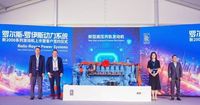As the world’s appetite for digital services continues to soar, the data centre industry is undergoing a seismic transformation—one marked by technological innovation, ambitious expansion, and a relentless pursuit of sustainability. From next-generation nuclear power deals in the United States and Europe, to record-breaking data centre builds in Africa, and new cloud partnerships spanning the globe, companies are moving swiftly to secure the reliable, clean energy and advanced infrastructure needed to fuel the digital age.
According to the International Energy Agency, global electricity consumption is projected to rise by 4% annually through 2027. This surge is driven by the rapid electrification of industries, explosive growth in data centre operations—especially those powered by artificial intelligence—and a renewed focus on industrial manufacturing. For major data centre operators, these trends present both a challenge and an opportunity: how to meet skyrocketing demand while ensuring their operations are sustainable, reliable, and future-proof.
Equinix, a global data centre giant, has taken a bold step in this direction by entering into agreements with several next-generation nuclear and fuel cell technology providers. The company’s partners include Oklo, Radiant, ULC-Energy, Stellaria, and Bloom Energy, all of whom are at the forefront of advanced energy solutions. This diversified approach combines traditional utility agreements, onsite power generation, and investments in emerging nuclear and fuel cell technologies, forming the backbone of Equinix’s strategy to support its expanding global portfolio of data centres.
Raouf Abdel, Executive Vice President of Global Operations at Equinix, underscored the urgency of these efforts. “Access to round-the-clock electricity is critical to support the infrastructure that powers everything from AI-driven drug discovery to cloud-based video streaming,” Abdel said, as reported by Data Centre Magazine. “As energy demand increases, we believe we have an opportunity and responsibility to support the development of reliable, sustainable, scalable energy infrastructure that can support our collective future.”
Among its most notable initiatives, Equinix has become the first data centre operator to ink a deal with a small modular reactor provider. The company will procure 500 megawatts (MW) of energy from Oklo’s Aurora powerhouses, which operate using nuclear waste—a significant leap toward both reliability and environmental stewardship. Equinix has also agreed to purchase 20 Kaleidos microreactors from Radiant, designed for rapid deployment and flexible onsite power needs. And in Europe, the company has signed a Letter of Intent with ULC-Energy and Rolls-Royce SMR for up to 250 megawatt electric (MWe) capacity to supply data centres in the Netherlands. ULC-Energy, in partnership with Rolls-Royce, plans to deploy 470MWe light water SMRs, leveraging technology recently chosen as the preferred bidder for the UK’s first small modular reactors.
Further diversifying its energy mix, Equinix has entered a pre-order power agreement for 500MWe with Stellaria, which is developing molten salt Breed & Burn reactors in collaboration with Schneider Electric and the French Atomic Energy Agency. These advanced reactors promise continuous self-breeding of fuel and recycling of spent fuels, pointing to a future where nuclear energy is not only cleaner but also more efficient and sustainable.
Fuel cell technology also plays a pivotal role in Equinix’s power strategy. The company has relied on Bloom Energy’s solid-oxide fuel cells for over a decade and plans to expand their deployment to more than 100MW across 19 data centres in six US states. These fuel cells have already enabled Equinix to avoid 285,000 metric tonnes of CO2 equivalent emissions and conserve significant amounts of water—a testament to the tangible environmental benefits of such innovations.
Ali Ruckteschler, Senior Vice President and Chief Procurement Officer for Equinix, highlighted the scale of the challenge: “The potential challenges to powering reliable and sustainable digital infrastructure are considerable. However, Equinix has always been at the forefront of energy innovation, signing the data centre industry’s first agreement with a SMR provider and pioneering the use of fuel cells a decade ago.” Ruckteschler added, “Powering AI infrastructure responsibly is a global priority. With Equinix’s operational expertise, trusted supply chain, and close partnerships with the U.S. and global governments and utilities, we are poised to deliver safe, secure and reliable AI solutions for our customers and the communities we serve.”
Equinix’s sustainability credentials are further bolstered by its achievement of 96% renewable energy coverage globally, with 250 sites operating exclusively on renewables as of 2024. The company is also advancing efficient data centre design, having phased in ASHRAE A1 Allowable standards since 2022 to reduce the energy needed for cooling by permitting wider operating temperature ranges. Plans are underway to deploy advanced liquid cooling technologies at more than 100 data centres across 45 metropolitan areas worldwide, a move expected to further enhance operational efficiency and support the power-hungry demands of AI and cloud computing.
Equinix is far from alone in its drive for innovation and expansion. In South Africa, Teraco—a Digital Realty company—has completed a 30MW expansion of its JB4 Bredell Campus in Ekurhuleni, Johannesburg. This addition makes JB4 the largest standalone data centre ever built in Africa, now boasting a 50MW critical IT power load. The new phase introduces six data halls, each capable of supporting 5MW of allocated critical IT power load, and features liquid-to-liquid cooling for high-density and AI workloads. According to Data Centre Magazine, this is a first for the continent, setting a new benchmark for data centre infrastructure in Africa.
Meanwhile, in China, Rolls-Royce Power Systems has begun production of its mtu Series 2000 G06 engine at the MTU Yuchai Power joint venture facility in Suzhou. This marks a milestone in Rolls-Royce’s localisation strategy, bringing manufacturing closer to one of its fastest-growing markets for mission-critical power solutions. The engines will support power generation applications across China and neighbouring regions, reinforcing the company’s commitment to global expansion and innovation.
Global partnerships are also reshaping the data centre landscape. NTT DATA recently announced a worldwide agreement with Google Cloud to accelerate AI-powered cloud innovation and deliver tailored infrastructure solutions for enterprise data centres. By combining NTT DATA’s expertise in AI and data engineering with Google Cloud’s analytics and cloud capabilities, the collaboration aims to provide scalable, customised solutions for businesses worldwide—a significant step in meeting the ever-growing demands of digital transformation.
In Australia, Docusign is set to open a local data centre in the fourth quarter of 2025, a move designed to support the country’s digital sovereignty and data security goals. The new facility will host Docusign’s Intelligent Agreement Management platform, enabling Australian organisations to store and process their agreement data domestically and comply with local privacy laws and industry regulations.
And in the United Kingdom, the data centre market is projected to grow by nearly a fifth, with close to 100 new sites planned over the next five years. This expansion, driven by the rising demand for AI processing power, will cement the UK’s status as the third-largest data centre market globally, trailing only the US and Germany. As reported by BBC News, the country currently hosts around 477 data centres, a figure set to climb as digital infrastructure becomes ever more critical to economic growth and technological advancement.
Amidst this flurry of activity, one thing is clear: the race to power the world’s digital future is on, and it’s being run on the twin tracks of innovation and sustainability. As data centre operators, technology providers, and governments work together to meet the challenges of rising demand, the foundations are being laid for a more connected—and cleaner—world.




